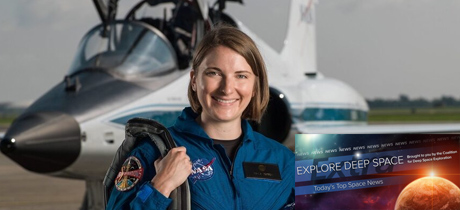In Today’s Deep Space Extra… NASA names a fourth crew member for its fall mission to the International Space Station. The agency’s new administrator, Bill Nelson, talks about his role and deep space exploration.
Human Space Exploration
NASA adds astronaut to commercial crew mission
SpaceNews.com (5/17): NASA on Monday announced the assignment of Kayla Barron, a nuclear engineer, to the next commercial crew mission that will launch four astronauts to the International Space Station (ISS) for a six-month mission. Barron will join Raja Chari and Tom Marshburn, also NASA astronauts, and European Space Agency (ESA) astronaut Matthias Maurer for the launch, currently planned for no earlier than October 23. The announcement is a sign that NASA does not expect to conclude an agreement with Roscosmos in time for a cosmonaut to use a seat on that flight. Barron was among 18 NASA astronauts selected to train for future missions to the Moon as part of NASA’s Artemis initiative.
China’s core space station module Tianhe completes in-orbit tests
Xinhuanet of China (5/18): The core stage of China’s space station, launched into orbit in late April, has checked out and is prepared for the upcoming arrival of the Tianzhou-2 cargo module. Tianhe recently completed platform function tests for rendezvous and docking, astronaut stay, and in-orbit performance checks for space equipment, according to the China Manned Space Agency (CMSA). (Editor’s note: Xinhuanet is a Chinese state-owned media outlet.)
Space Science
China’s newly landed Mars rover Zhurong likely to roll into action this weekend
Space.com (5/17): China’s Zhurong Mars rover, which touched down safely on the Red Planet last weekend, appears poised to roll off its lander to begin studying its surroundings and checking out its systems and instruments. The rover and its lander platform descended onto Utopia Planitia in the northern hemisphere of Mars.
The Milky Way may have grown up faster than astronomers suspected
Science News (5/17): A new study suggests the Milky Way galaxy was quite mature even before acquiring its appearance evident today, which was shaped primarily by a collision with a dwarf galaxy about 10 billion years ago. The findings were published in the journal Nature Astronomy. Observations with the European Space Agency’s (ESA) Gaia spacecraft and NASA’s Kepler space telescope contributed to the findings.
Opinion
Why the China-Russia space alliance will speed up human exploration of Mars
The Space Review (5/17): Earlier this year, Russia and China disclosed a Memorandum of Understanding (MOU) for the development of a research base at the Moon. The MOU represents a challenge to NASA’s Artemis initiative, according to John Wolfram. It’s unclear whether the U.S. is being challenged as political theater, or if the challenge matches the adversity between the U.S. and the former Soviet Union during the Cold War that triggered the race to the Moon, won by the U.S. “It just might accelerate the planning and execution of a bold U.S. crewed mission to Mars, with the support of an American public and body politic filled with the fire to be first, and thus reinforcing the long-standing supremacy of the U.S. in space for decades to come,” writes Wolfram in and op-ed.
Other News
ULA Space Force missile tracking satellite, first Atlas V launch of 2021- take two
Coalition Member in the News – United Launch Alliance
NASASpaceflight.com (5/17): United Launch Alliance (ULA) is reattempting the launch of a new Space Based Infrared System (SBIRS) reconnaissance satellite into Geostationary transfer orbit. Following a scrub on Monday, liftoff is now scheduled for no earlier than May 18 at approximately 1:31 p.m. EDT. The flight will mark the first 2021 launch of ULA’s Atlas V rocket and the second launch by the company this year following the April launch of NROL-82, which utilized a Delta IV Heavy rocket.
NASA Chief Bill Nelson talks rockets, Moon plans and partnerships
The Verge (5/17): In an interview with The Verge, former Senator Bill Nelson, now NASA administrator, talks about the first challenges of his new role. Some of the immediate issues he has to deal with are the Artemis Human Landing System (HLS) program award, talks of Russia potentially distancing itself from U.S. partnerships and instead partnering with China, and taking human deep space exploration goals to fruition with current programs such as the Space Launch System (SLS).

